Water and Wastewater Engineering
Подождите немного. Документ загружается.

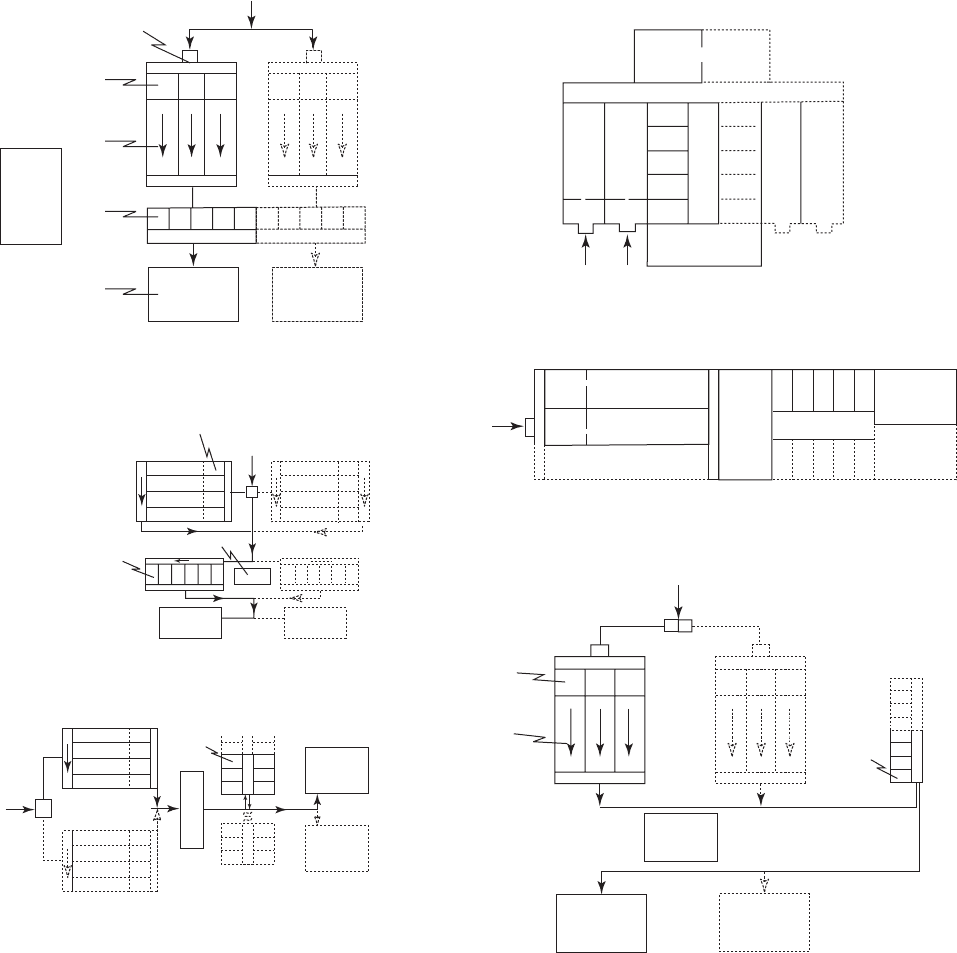
16-18 WATER AND WASTEWATER ENGINEERING
(a)
(c)
(c)
(b)
Floc.
tanks
Rapid
mix
Sed.
tanks
Control bldg.
Clearwell
Filters
floc./sec
tanks
Rapid
mix
Chemical
&
control
building
Filters
Clearwalls
Clearwalls
(b)
Filters
Floc./sec
tanks
Floc./sec
tanks
Chemical &
control building
Rapid mix
Clearwells
(c)
Operations
building
Clearwell
Floc.
basins
Sed.
basins
Rapid
mix
Filters
Rapid
mix
Sed.
tanks
Filters
Control bldg.
Clearwell
Rapid mix
basin
Floc.
basins
Sed.
basins
Filters
Clearwell
Operations
building
FIGURE 16-7
B a sic styles of plant layout. Linear ( a ), Compact ( b ), and Campus ( c ). Future plans shown by dotted lines.
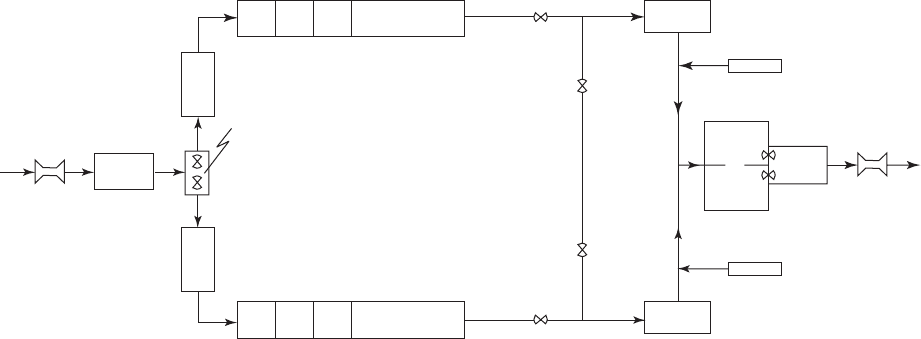
DRINKING WATER PLANT PROCESS SELECTION AND INTEGRATION 16-19
layout. These include: (1) easier construction because each treatment process is easily accessible,
(2) less potential for structural damage between different processes because of differential set-
tling, (3) upgrading with new technology between units is relatively easy, (4) if the site is not flat,
there is
a potential savings in earthwork, and (5) an inherent increase in safety is realized because
of separation from chemical spills and/or fire.
The disadvantages of the linear and campus styles are (1) larger plant site requirements, (2) more
yard piping, (3) operators must travel greater distance between each process, an
d (4) construction
costs may be greater.
When space is not a constraint, a linear layout generally allows the maximum flexibility for
expansion. Redundancy and flexibility are enhanced if the units are interconnected in such a way
that the flow through the plant can be shuttled from one treatment train to another a
s shown in
Figure 16-8 . Because chemicals must be delivered to the plant, connection to the transportation
net becomes an integral part of the layout. Likewise, because residuals are generally transported
offsite, the residuals handling system is an integral part of the plant layout.
Kawamura (2000) emphas
izes two points in laying out the plant. The first is to provide a
single application point for all the pretreatment chemicals. The second is to provide a single
chemical feed point to the filter influent for all the filters and use this scheme for the combined
filter water prior to the clearwell. The single point application scheme is recommended because it
sim
plifies the chemical feed system and provides uniform water quality control.
Plant Hydraulics
The plant hydraulics are represented by a drawing that shows the hydraulic grade line across the
treatment plant. The drawing must show the elevations of the walkway (top of the structure), the
water level, and the bottom elevation of each unit process as well as the invert and crown of all
the connecting pipes and the invert of all the channels. An example hydraulic profile is
shown in
Figure 16-9 .
Flash
mixer
Flow split weir box
w/weir bypass gates
Flowmeter
Flowmeter
Flowmeter
Flocculation tanks
Flocculation tanks
Sedimentation
tanks
Sedimentation
tanks
Filters
Filters
Clearwells
Chlorine
Chlorine
Pump
station
Flowmeter
FIGURE 16-8
P r o cess train scheme to improve treatment flexibility.

16-20 WATER AND WASTEWATER ENGINEERING
755
760
750
745
740
735
730
725
720
715
Existing
underground
reservoir
Existing
suction well
(1 of 2 shown)
Existing
high service pumps
(1 of 4 shown)
Top gallet wall
Filtered water
Existing sub-basement
From
Recarbonation
EL 736.50
EL 734.25
Existing filters
(1 of 4 shown)
HWL 737.40
EL 734.90
EL 725.95
Floor EL 714.42
New Existing
Filter influent
Filter influent
To distribution
system
755
760
750
745
740
735
730
725
720
715
From wells
Raw water
Settled water
Finished floor
Aerator
Clarifier 1 Clarifier 2
Recarbonation
tank
Tank
drain sump
Top of weir box
HWL 742.67
HWL 741.12
HWL 740.12
Clarifier inlet
EL 727.00
EL 743.42
EL 736.50
721.08
EL 741.71
Top of weir
Top of slab
720.08
Top of slab
Top of weir
EL 740.71
EL 737.53
716.42
HWL 738.53
To filter
influent
Top of
slab
NOTE: High water levels (HWL) calculated at 23,000 m
3
/d with parallel
flow through clarifiers and one filter in backwash
FIGURE 16-9
T ypical hydraulic grade line for a softening plant.

DRINKING WATER PLANT PROCESS SELECTION AND INTEGRATION 16-21
I deally, the water flows through the plant by gravity after it is pumped to the head end of the
plant. This minimizes the number of pumps to move the water through the plant. The elevation of
the surface of the water as it flows through the plant follows the hydraulic grade line. These ele-
vations are set by the design based on calculations of headloss through the various s
tructures of
the plant. Once the headlosses are known, the elevations of the surface water are set by working
from a selected elevation for the discharge from the rapid sand filter or from a selected elevation
for the influent to the plant. The elevation of the water surface in each process upstream is set to
overcome the headloss in moving the water to the next downstream proc
ess.
Some of the headloss calculations have already been demonstrated (e.g., for pipes, baffle
walls, and the rapid sand filter in Chapters 3, 6, and 11, respectively). Other headlosses that need
to be estimated are the losses in the orifice weir from settling tanks and the losses in channels
leading from one process to another. The losses
in the orifice weir may be estimated with Equa-
tion 6-18, repeated here:
QCAgh
dorifice
/
()2
12
(16-1)
where Q flow rate through orifice, m
3
/ s
C
d
coefficient of discharge
A area of orifice, m
2
g gravity acceleration 9.81 m/s
2
h headloss through the orifice, m
The coefficient of discharge varies from 0.60 to 0.80. The estimate of orifice headloss is illus-
trated in Example 16-1.
Example 16-1. Design the orifice for Stillwater’s launders (Example 7-4). Assume the orifices
are 5 cm in diameter and that they are placed 0.30 m on
centers. From Example 7-4, there are six
tanks for the design flow rate of 43,200 m
3
/ d and each tank has 55.5 m of launder.
Solution:
a . Estimate the number of orifices per tank.
()( )55 5 211. m of launder sides per launder 110. m
At 0.30 m intervals, the number of orifices is
111 0
0 30
370
.
.
m
m/orific e
orifices
b. Determine the flow rate per tank in compatible units with Equation 16-1, i.e. in m
2
/s.
43 200
6 86 400
00833
3
3
,
,
.
m /d
tankss/d
m /
()( )
ssper tank
c. Estimate the flow rate per orifice.
Q
N
00833
370
3
. m /s per tank
orifices per tan
kk
m /s orifice
225 10
4 3
.
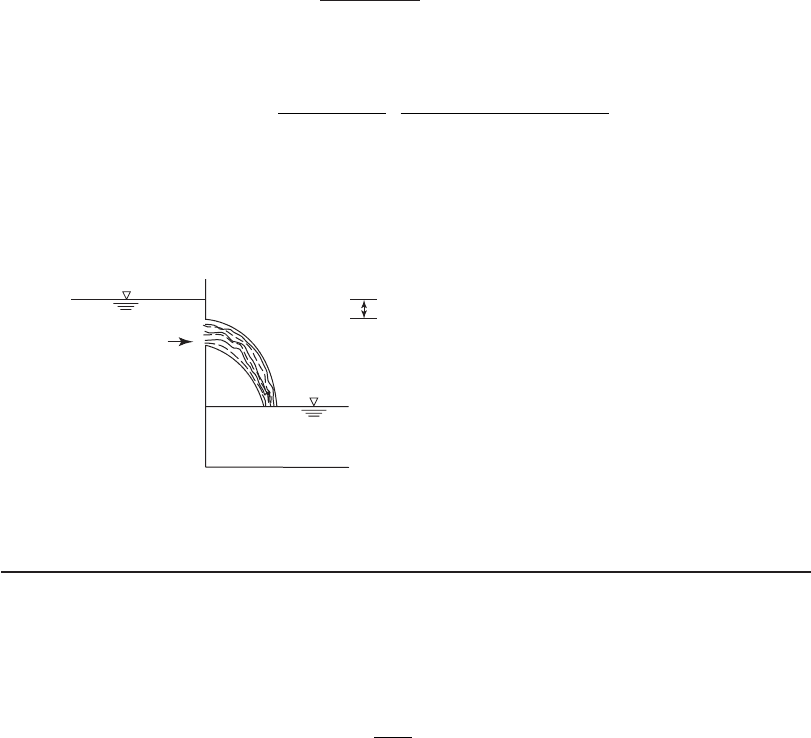
16-22 WATER AND WASTEWATER ENGINEERING
d. Calculate the area of each orifice.
A
p()005
4
1 963 10
2
3 2
.
.
m
m
e. Calculate the headloss for one orifice using a coefficient of discharge of 0.60.
h
1
2981
225 10
060 196
2
12
4 3
()()(.
.
..m/s
m /s
/
33 10
0 022 2 2 2
3 2
m
m or cm or cm
)
⎛
⎝
⎜
⎞
⎠
⎟
..
Because the orifices are all at the same elevation, this is the headloss for water flowing
out of the sedimentation tank into the launder. A sketch of the cross section of the laun-
der and the water levels in the tank and launder are shown below.
Tank
Launder
Orifice
2 cm
Comment. This is a theoretical estimate. Corrosion or encrustation of the orifice will change
the diameter and, thus, the headloss. A safety factor of 2 in the estimated headloss is not unrea-
sonable. This would yield an estimate of 4 cm headloss.
The headloss in the fall of the water from the orifice to the surface level of the water in the
launder requ
ires an estimate of the depth of water in the launder. This is, in essence, a design of
the launder width and depth. This is an open channel flow problem. The flow in an open channel
may be estimated using Manning’s equation:
Q
n
AR S
channel
//
100
2 3 12
.
()()
(16-2)
where Q
channel
flow rate in channel, m
3
/ s
n Manning’s coefficient, dimensionless
A cross-sectional area of flow, m
2
R hydraulic radius, m
A/P
P wetted perimeter, m
S slope of bottom of the channel, m/m
The coefficient 1.00 has implicit units of m
1/3
/ s. The wetted perimeter is the perimeter where the
water is in contact with walls and floor of the channel. Manning’s n i s taken as 0.012 for finished
concrete and 0.018 for steel. The estimate of the surface water level in a launder is illustrated in
Example 16-2.
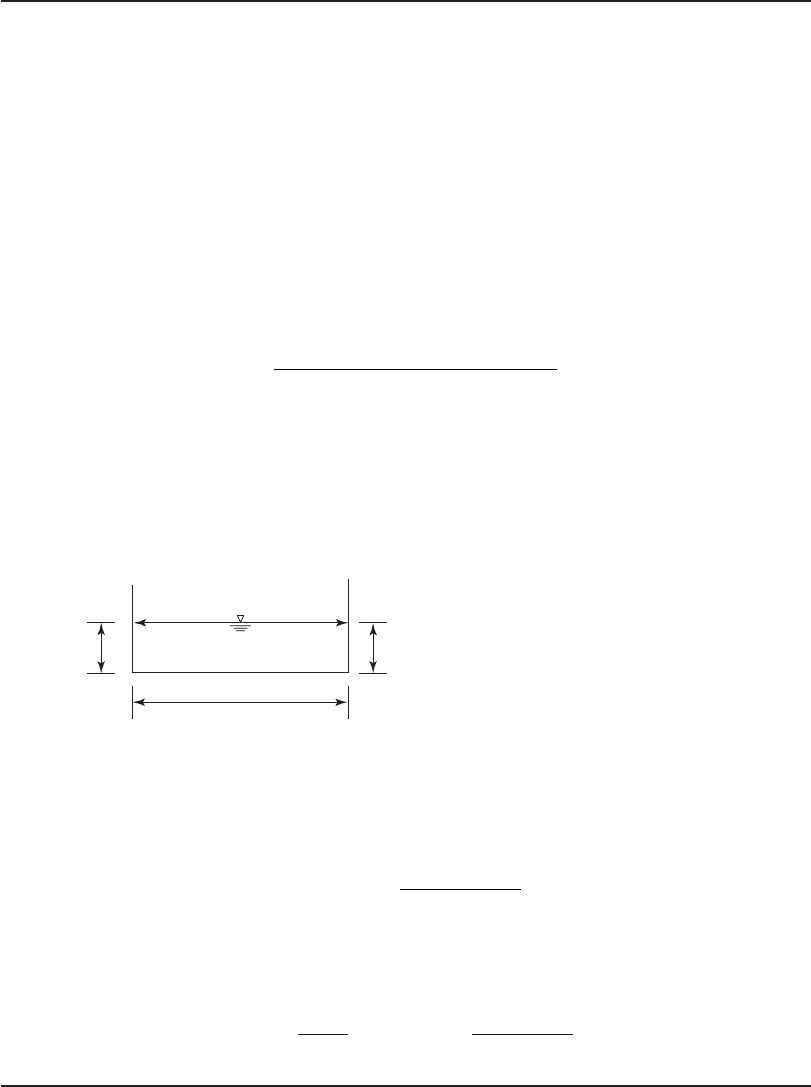
DRINKING WATER PLANT PROCESS SELECTION AND INTEGRATION 16-23
Example 16-2. E stimate the cross-sectional dimensions of a launder for Stillwater’s (Examples
7-4 and 16-1) settling tank and estimate the maximum depth of water in the channel. Assume the
launder channel is steel and has a slope of 0.002 m/m and a freeboard of 10 cm above the water
level in the settling tank.
Solution:
a . An iterative solution is req
uired because neither the depth or width of the flow in the
channel is known. The approach used here is to assume a channel width in the range of
nominal values (i.e., 0.30 to 0.60 m) and use a spreadsheet tool such as Solver* to deter-
mine the height of the water for a solution to Manning’s equation.
b. From Example 7-4, the design flow rate is 43,200 m
3
/ d for six tanks and there are three
launders per tank. The flow rate at a launder exit is then:
Q
channel
m /d
tanks lau nders
43 200
6 3 8
3
,
()( )(
66 400
0 02778
3
,
.
s/d
m /s
)
c. Using the sketch below and assuming a channel width of 0.45 m, the cross-sectional area
of the water flow is
Ay ()()045. m
where y is the depth of flow.
y
y
0.45 m
d . The wetted perimeter is then
Py045 2. m ()
e . The hydraulic radius is
R
y
y
()()
()
045
045 2
.
.
m
m
f . For steel, Manning’s n 0.018.
g. With the variables defined, Manning’s equation is
0 0278
100
0 018
045
045
3
2 3
.
.
.
.
.
m /sm
/
[( )( )]
(
y
mm
/
)( )
()
()
y
y045 2
0 002
12
.
.
⎡
⎣
⎢
⎤
⎦
⎥
*Solver is a tool in Excel
®
. Other spreadsheets may have a different name for this program.
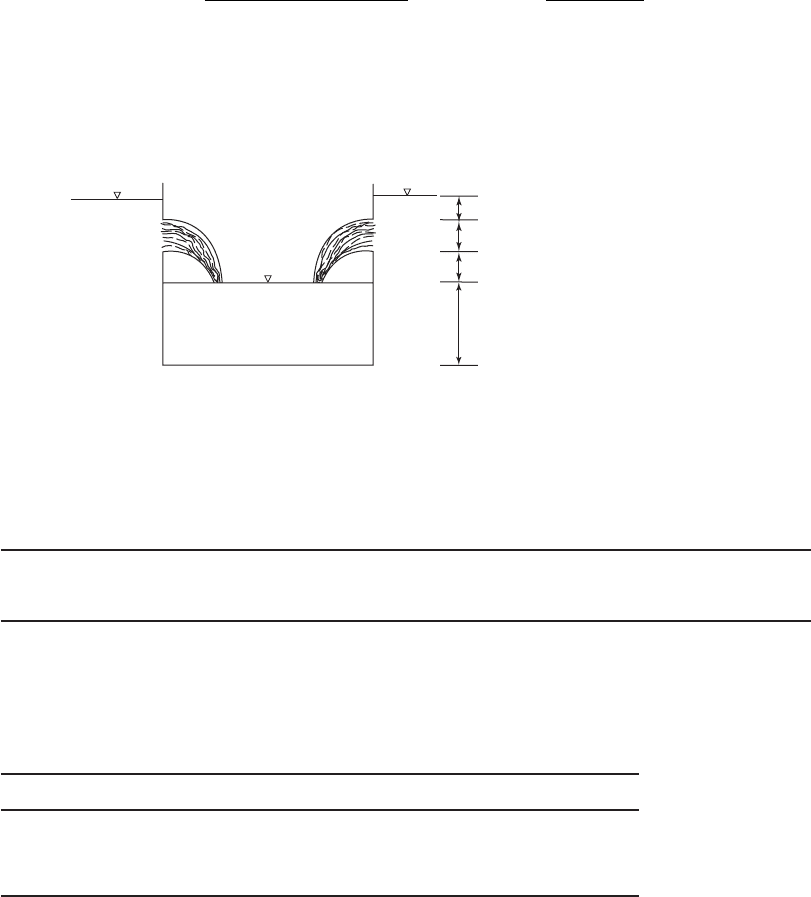
16-24 WATER AND WASTEWATER ENGINEERING
h . Simplifying in terms of the variable y,
()()
()( )( )
0 0278 0 018
100 045 0 002
3
1
..
.. .
m /s
m
/22
2 3
0 0248
045
045 2
.
.
.
()
()()
()
y
/
m y
y
⎡
⎣
⎢
⎤
⎦
⎥
i. The right-hand side of the equation was entered in a spreadsheet with a starting value of
y 0.30 and goal value of 0.0248. The Solver solution is y 0.22219 m or 0.22 m.
j. Combining the results from Example 16-1 and the width and depth found here yields a
cross section as shown in the following sketch:
Tank
Launder
4 cm
5 cm
5 cm
22 cm
k . Using the sketch above, the headloss for the settling tank outlet is then:
4 5514 0 14cm cm cm cm or m .
Comment. This is an approximate solution because it ignores the fact that there will be a back-
water curve in the launder. A more exact solu tion may be found using the techniques described
by Reynolds and Richards (1996).
E xample 16-3 illustrates the construction of the hydra
ulic grade line.
Example 16-3. Estimate the elevations and plot the hydraulic grade line for a small softening
plant given the dimensions and headloss data shown below. The top of the clearwell storage tank
is at an elevation of 180.88 m above mean sea level. The weir controlling the water level in the
clearwell is set 2.00 m below the top of the tank.
Solution:
a . Begin with the top of the tank (elev. 180.88 m). The weir is set 2.00 m below the top of
the clearwell at elevation 178.88 m.
Tank Overall height, m Water depth, m Headloss, m
Upflow solids contact7.50 6.87 0.14
Recarbonation 3.502.50 0.14
Rapid sand filter 4.80
3.50
a
3.50
a
Water depth is measured from the filter floor, i.e., the bottom of the drainage blocks.
Tank vertical dimensions and headloss data
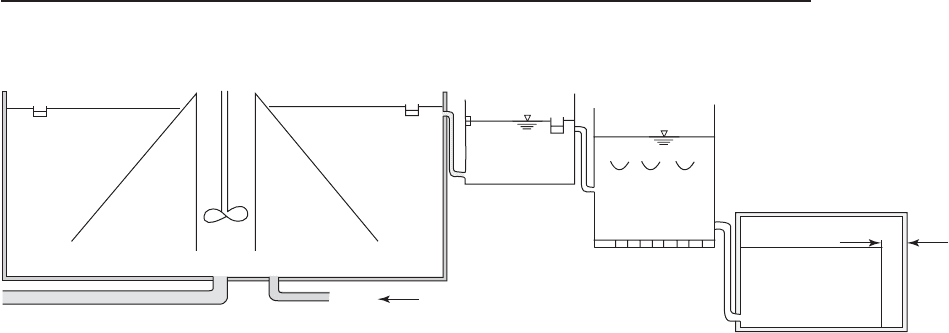
DRINKING WATER PLANT PROCESS SELECTION AND INTEGRATION 16-25
b. The bottom of the rapid sand filter is level with the weir at elevation 178.88. At the
maximum head on the filter, the water level is 3.50 m above the bottom of the filter box.
This water level is at an elevation of 182.38 m. The filter box is 4.80 m deep, so the top
of the filter box is at an elevation of 178.88 4.80 183.68 m.
c. The headloss across the recarbonation chamber is 0.14 m. The water surface in the re-
carbonation chamber is placed 0.14 m above the maximum water level in the rapid sand
filter. This yields a water elevation of 182.38 m 0.14 m 182.52 m. The overall
height of the recarbonation chamber is 3.50 m and the water depth is 2.50 m. Thu s, the
water surface is 1.00 m below the top of the chamber. This places the top of the chamber
at an elevation of 182.52 m 1.00 m
183.52 m and the bottom of the chamber at an
elevation of 182.52 m 3.50 m 180.02 m.
d. The headloss across the upflow solids contact basin is 0.14 m. The water surface in the
upflow solids contact basin is placed 0.14 m above the maximum water level in the recar-
bonation chamber. This
yields a water elevation of 182.52 m 0.14 m 182.66 m. The
overall height of the upflow solids contact basin is 7.50 m and the water depth is 6.87 m.
Thus, the water surface is 0.63 m below the top of the upflow solids contact basin. This
places the top of the upflow solids contact basin at an elevation of 182.66 m
0.63 m 18
3.29 m and the bottom of the chamber at an elevation of 183.29 m
7.50 m 175.79 m.
e. The profile of the hydraulic grade line is shown in Figure 16-10 .
Comments:
1 . Losses in pipes and conduits were ignored in this example. Although the distances be-
tween process units is generally not very large,
significant losses can occur if the pipes
are too small or if minor losses due to valves (especially those not fully open) are not
taken into consideration.
2. V-notch weirs may be used instead of orifices.
Upflow solids contact basin
182.66
183.29
182.52
183.52
180.02
182.38
180.88
178.88
168.88
183.68
178.88
175.79
Sludge
ClearwellRecarbonation Rapid sand filter
Water from wells
Outlet weir
FIGURE 16-10
H ydraulic grade line for a small softening plant. Elevations are above mean sea level. See Example 16-3 for calculations.

16-26 WATER AND WASTEWATER ENGINEERING
Supervisory Control and Data Acquisition (SCADA)
Until the 1960s, almost all control of the operation of a water treatment plant was by manual
methods either by direct operator intervention or by hard-wired electronic switches. The advent
of modern computing technology has radically changed the design of process instru mentation
and controls.
The current generation of control sy
stem software has evolved from the original distributed
control system (DCS) that was developed for in-plant applications where high-speed networking
was available to the SCADA systems that were originally developed for connection over low-
speed data lines. Over time, the SCADA system and DCS have developed very similar capabili-
ties. In the current literature, the SCADA terminology prevails. It will be used in this
discussion
with the understanding that it applies equally well to DCS.
This discussion is an overview. In keeping with the second canon of the code of ethics, the de-
sign of the instrumentation and control system must be conducted by instrumentation and control
system engineers. Instrum
entation, programming, configuration, and other details of the SCADA
system will not be covered in this discussion. The chapter by Kubel (2005) and publications of
AWWA (1993, 2001) provide a more comprehensive discussion of instrumentation and controls.
For convenience, a glossary of abbreviations and terms used in de
scribing SCADA is pre-
sented in Figure 16-11 .
Driving Forces for Implementing SCADA. There are a number of engineering and business
reasons for implementing a SCADA system (Kubel, 2005):
• A need for improved treatment quality. Modern automation and control allows closer and
more consistent water treatment than is possible with manual operation.
• Tighter regulatory requirements. A s sampling an
d record keeping requirements increase,
significant labor savings can result from adding on-line instruments with automatic data
logging.
• A need to reduce costs. Some cost savings through automation include reduced chemical
usage, reduced equipment wear, and optimization of energy
usage.
Field bus—digital communication to field devices
GUI—graphical user interface
HOA—three-way switch (Hand-Off-Auto) that allows manual (Hand) operation, turns the unit
off, and automatically (Auto) runs the operation
LOI—local operator interface
MCC—motor control center
PDA—pocket computer (personal data aquis
ition)
PI—proportional control algorithm
PID—proportional/integral/derivative control algorithm
PLC—programmable logic controller
RTU—remote terminal unit
SP—set point
UPS—uninterruptible power supply
FIGURE 16-11
Glossary of SCADA terms .
DRINKING WATER PLANT PROCESS SELECTION AND INTEGRATION 16-27
• Improved labor effi ciency. Labor savings are achieved by automating tasks and providing
data that allows operators to anticipate equipment failure and perform preventive mainte-
nance.
• Quicker response to emergencies. Centralized control can reduce the time to make changes
in water production during a crisis.
Hierarchy of Control. Water treatment plants often use a co
mbination of manual, semiauto-
matic, and fully automatic control. The hierarchy generally includes local control and computer
control.
The local control includes, for example, manual controls on motor starters, valve actuators,
and pumps. Operators c an set s
uch things as variable-frequency drive (VFD) motor speeds and
chemical flow rates. It also includes hard-wired interloc ks to function when the computer sys-
tems are not in service and to protect personnel while they work on equipment.
Computer control generally includes all fully au
tomatic operations, manual operation from
the computer keyboard, and optimization by computer algorithms.
Types of Control Algorithms. Some example algorithms include sequencing for start-up and
shut-down of processes and continuous control of process operation. The common algorithms are
feed-forward,
feed-back, proportional, and compound control.
An example of a feed-forward system is the polymer feed shown in Figure 16-12 . The poly-
mer flow is maintained at a fixed ratio to the main flow into the mixing tank. The rate controller
[ F (flow)] continuously computes the required polymer flow based on the main line flow.
An example of the feed-back system is the level controller shown in Figu re 16-13 . The op-
erator enters a level set point. The controller continuously measures the level in the tank. If the
tank level is higher than the set point, the controller adjusts the valve to reduce the flow. If the
tank level is low, the controller opens the valve.
Proportional control adjusts the controlled device as a proportion of the measured process
variable. In contrast to the ratio system, the change in the controlled device rises or falls with
a change in the measured variable according to som e mathematical relationship (e.g., rate of
change, power law, exponential, or cubic spline). The PID offers integration or differentiation
algorithms to refine the
control process. For example, if the process variable changes rapidly,
controller output is reduced by an amount proportional to the rate of change.
Compound control is a combination of techniques. A common combination is feed-forward
plus feed-back. In a highly nonlinear system such as pH
control, feed-forward plus feed-back
and a proportional nonlinear algorithm reduces overshoot and hunting by the feed pumps. Chlo-
rination systems with compound control are also favored to maintain adequate residuals without
over-dosing.
Typical Water Treatment Control Strategies. The following outline provides exam ples of
control of some generic water treat
ment processes (Kubel, 2005).
• Raw water pump control. T ypically the operator sets the desired plant influent flow. This
becomes a flow set point to a feed-back flow controller.
• Coagulation. Coagulant and polymers are fed using flow or flow/turbidity feed-forward
control. Alternatively, feed-back from a streaming current detector is
used.
